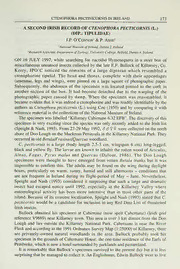
A second Irish record of Ctenophora pecticornis (L.) (Dip.: Tipulidae) PDF
Preview A second Irish record of Ctenophora pecticornis (L.) (Dip.: Tipulidae)
CTENOPHORAPECTINICORNIS INIRELAND 173 A SECOND IRISH RECORD OF CTENOPHORA PECTICORNIS (L.) (DIP.: TIPULIDAE) J.P. O'Connor' & P. Ashe^ ^NationalMuseumofIreland,Dublin2,Ireland -ResearchAssociate,DepartmentofZoology, UniversityCollege,Belfield,Dublin4,Ireland. ON 16 JULY 1997, while searching for eucoilid Hymenoptera in a store box of miscellaneous unnamed insects collected by the late E.F. Bullock of Killamey, Co. Kerry, JPO'C noticed the remains of a large dipteran which resembled a ctenophorine tipulid. The head and thorax, complete with their appendages (antennae, legs and wings), were pinned on a large square of photographic paper. Subsequently, the abdomen of the specimen was located pinned to the cork in another section of the box. It had become detached due to the warping of the photographic paper caused by damp. When the specimen was reassembled, it became evident that it was indeed a ctenophorine and was readily identifiable by the authors as Ctenophora pecticornis (L.) using Coe (1950) and by comparing it with reference material in the collections ofthe National Museum ofIreland. The specimen was labelled "Killamey Cahimane 6.32 EFB". The discovery ofthis specimen is very exciting since the species was only recently added to the Irish list (Speight & Nash, 1993). From 27-29 May 1992, SS99 were collected on the north shore ofDoo Lough on the Muckross Peninsula in the Killamey National Park. They occurred in oldBetulalFraxinuslQuercus woodland. C. pecticornis is a large (body length 2.5-3 cm, wingspan 6 cm) long-legged, black and yellow fly. The larvae are known to inhabit the rotten wood ofAesculus, Alnus, Fagus, Pyrus malus and Quercus (Dufour, 1986). The Doo Lough specimens were thought to have emerged from rotten Betula trunks but it was impossible to confirm this. The adults may be found on the wing during daylight hours, particularly on warm, sunny, humid and still afternoons - conditions that are not frequent in Ireland during its flight-period of May - June. Nevertheless, Speight and Nash (1993) considered it surprising that such a large and dramatic insect had escaped notice until 1992, especially in the Killamey Valley where entomological activity has been more intensive than in most other parts of the island. Because of its extreme localisation, Speight and Nash (1993) stated that C. pecticornis would be a candidate for inclusion in any Red Data List of threatened Irish insects. Bullock obtained his specimen at Cahimane (now spelt Cahemane) (Irish grid reference V9689) near Killamey town. This area is over 3 km distant from the Doo Lough and lies outside the Killamey National Park. Cahernane is near the River Flesk and according to the 1991 Ordnance Survey Map (1:25000) ofKillamey, there are privately-owned natural woodlands in the area. Bullock probably took his specimen in the grounds of Cahemane House, the one-time residence of the Earls of Pembroke, which is now a hotel surrounded by parklands and pastureland. It is remarkable that Bullock's specimen survived to the present day but it is less surprising that he managed to collect it. An Englishman, Edwin Bullock went to live 174 ENTOMOLOGIST'S RECORD, VOL. 110 25.vii.1998 in Killamey in or before 1912. There he became a professional photographer- hence his use ofphotographic paper for carding some of his specimens. He was the last of the great local collectors in Ireland. He collected, when weather permitted, every day for more than 50 years usually within a few miles of his house due to the lack of a car. Indeed, Cahemane was but a short distance from his home Flesk View House (now sadly demolished) on the Muckross Road. He eventually built up a collection ofbeetles unrivalled in Ireland. However, he also collected specimens ofmany other groups. For example, his keen eye detected in his garden the only Irish specimen of the beautiful little diapriid Coiynopria solida Thomson (O'Connor & Ashe, 1992). A charming account ofBullock is given by Beime (1985). After his death in 1965 at the age of 86, his collection was initially stored locally where sadly it suffered from damp. When it was eventually transferred to the National Museum of Ireland in 1968, the contents of many store-boxes had been destroyed although the main collection housed in a cabinet and other material did survive intact. Curiously, the store-box containing C. pecticornis was not included in the 1968 donation. Instead, it was discovered by K.G.M. Bond in University College Cork many years later. It had been in the possession of Professor F.J. O'Rourke and the contents had suffered little damage. In 1989, the box with its specimens was presented to the National Museum ofIreland. Acknowledgements The authors wish to thank K.G.M. Bond and the authorities of University College Cork for presenting the store-box to the National Museum. Without their foresight, this discovery could not have been made. References Beime, B.P., 1985. Irish Entomology: the first hundred years. Irish Naturalists' Journal Special EntomologicalSupplement: 1-40. Coe, R.L., 1950. Family Tipulidae. In Coe, R. L., Freeman, P. and Mattingly, P. F. (eds) Diptera. 2. Nematocera: families Tipulidae to Chironomidae.Hdbks. Ident. Br. Insects 9 (2): 1-216. Dufour, C, 1986. Les Tipulidae de Suisse (Diptera, Nematocera). Documenta Faunistica Helvetiael: 1-187. O'Connor, J.P. & Ashe, P., 1992. A provisional Hst of the Irish Diapriinae (Hymenoptera: Diapriidae). Bulletin ofthe IrishBiogeographicalSociety 15: 68-90. Speight, M.C.D. & Nash, R., 1993. Chrysotoxum cautum, Ctenophora ornata, C. pecticornis, Helophilus trivittatus and Mesembrina mystacea (Diptera), insects new to Ireland. Irish Naturalists' Journal 24: 231-236. Information wanted: insects in poetry As part of a research project into insects in poetry, I would like to hear from anyone who knows of poems by any poet, classical or contemporary, published or unpublished in which an insect or insects of any order are featured specifically or generally. All correspondence will be acknowledged.- John Tennent, 1 Middlewood Close, Fylingthorpe, Whitby, North Yorkshire Y022 4UD.
